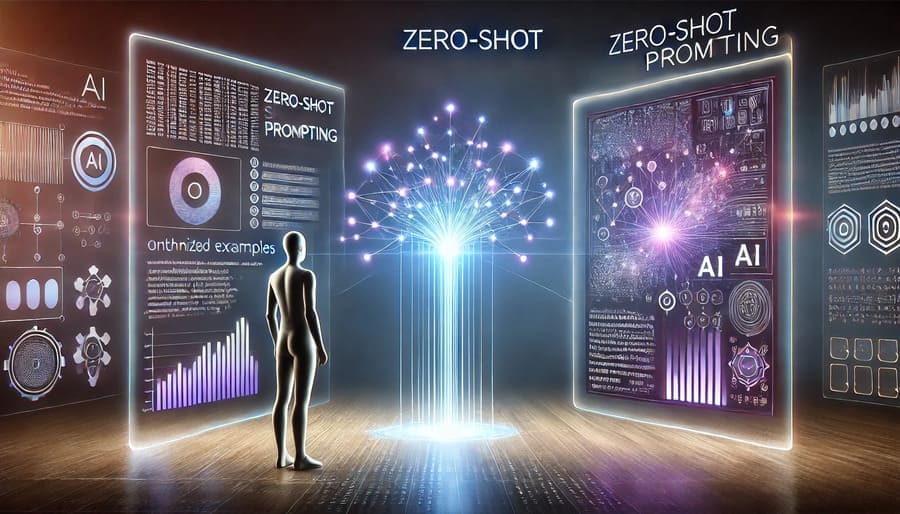Zero-Shot Prompting

Zero-shot prompting represents one of the most remarkable capabilities of modern large language models (LLMs). Unlike other prompting techniques that require examples or extensive guidance, zero-shot prompting allows AI systems to perform tasks they’ve never explicitly been trained on, using only a clear instruction. This approach demonstrates the true power of transfer learning and the generalization capabilities of today’s advanced AI systems.
Zero-shot prompting is exactly what it sounds like: asking an AI model to perform a task without giving it any specific examples of that task being completed. The model must rely entirely on its pre-training knowledge to understand what’s being asked and generate an appropriate response.
For instance, you might simply instruct: “Classify this customer feedback as positive, negative, or neutral: ‘The data pipeline implementation exceeded our expectations in terms of throughput, though documentation could be improved.'”
The model must understand several implicit tasks here:
- What constitutes feedback classification
- How sentiment analysis works
- What criteria determine positive, negative, or neutral sentiment
- How to balance mixed sentiments in a single statement
Zero-shot capabilities emerge from the way modern LLMs are trained. Through exposure to vast and diverse text during pre-training, these models develop:
- Generalized knowledge representations: Understanding concepts beyond specific examples
- Task inference abilities: Recognizing what’s being asked without explicit examples
- Cross-domain reasoning: Applying knowledge from one area to solve problems in another
- Linguistic pattern understanding: Recognizing task structures from natural language instructions
This allows LLMs to make what appear to be “intuitive leaps” when faced with new tasks.
Zero-shot prompting works particularly well for:
- Common tasks with standard interpretations: Classification, summarization, translation
- Tasks with clear instructions: When the expected output format is unambiguous
- General knowledge queries: Leveraging the model’s broad pre-training exposure
- Simple creative generations: Basic content creation with clear parameters
- Initial exploration: Testing capabilities before refining with more structured approaches
Without examples to clarify your intent, your instructions must be crystal clear:
Poor: “Analyze this data.” Better: “Analyze this sales data to identify the top three contributing factors to the Q4 revenue decline, considering seasonal patterns, marketing spend, and competitive product launches.”
Clearly specify the desired response structure:
“Generate a JSON object representing a database schema for an e-commerce application. Include tables for users, products, orders, and inventory with appropriate fields and relationships. Format the response as valid JSON with proper indentation.”
Establish clear parameters for the task:
“Write a technical specification for implementing a real-time data pipeline. Limit the response to 500 words, focus on architecture rather than code implementation, and prioritize scalability considerations.”
Help the model understand what constitutes success:
“Evaluate the following machine learning approach for time series forecasting. Your evaluation should assess computational efficiency, accuracy potential, and implementation complexity, with particular attention to how it handles seasonal variations.”
Offer relevant background information:
“As a healthcare data engineer presenting to non-technical hospital administrators, explain how implementing a data lake would improve patient care outcomes. Consider their priorities of regulatory compliance, budget constraints, and immediate operational improvements.”
Break complex requests into simpler components:
“To create a comprehensive data quality assessment framework:
- First, identify the key dimensions of data quality relevant to financial systems.
- For each dimension, define appropriate metrics that can be quantitatively measured.
- Then, outline a process for establishing thresholds for these metrics.
- Finally, suggest visualization approaches for presenting quality scores to stakeholders.”
Give the AI a specific perspective to adopt:
“As an experienced cloud architect who specializes in optimizing costs, review this AWS infrastructure configuration and identify potential inefficiencies.”
Use successive zero-shot prompts to refine outputs:
Initial: “Generate a list of potential data sources for tracking consumer sentiment about sustainable products.” Follow-up: “For each of these data sources, identify the primary challenges in data collection and processing.” Final: “Recommend the three most promising sources based on data richness, accessibility, and processing complexity.”
While zero-shot prompting demonstrates the impressive capabilities of modern AI, it’s not always the optimal approach. Consider these tradeoffs:
Zero-Shot Advantages:
- Requires less prompt engineering effort
- Saves token usage in the prompt
- Tests the model’s true generalization ability
- Often sufficient for standard tasks
Few-Shot Advantages:
- Provides clearer guidance for unusual formats
- Demonstrates specific reasoning patterns
- Helps with niche domain knowledge
- Improves consistency across multiple outputs
When applying zero-shot prompting in data engineering contexts:
- Start broad, then narrow: Begin with zero-shot for initial exploration, then add examples if needed
- Verify critical outputs: For complex transformations or analyses, validate results against known examples
- Use clear technical terminology: Leverage precise technical terms familiar to the model
- Combine with tools: Pair zero-shot instructions with code execution for data manipulation
- Document prompt effectiveness: Track which zero-shot approaches work best for recurring tasks
Zero-shot prompting represents perhaps the most elegant demonstration of modern AI capabilities. By crafting clear, detailed instructions, data engineers can leverage these models’ generalization abilities to solve novel problems without extensive example preparation. As models continue to improve, the range and complexity of tasks approachable through zero-shot prompting will only expand, streamlining workflows and enabling more intuitive human-AI collaboration.
#ZeroShotPrompting #AIGeneralization #PromptEngineering #LLMCapabilities #NoExampleAI #DataEngineeringAI #TransferLearning #AIIntuition #NaturalLanguageInstructions #AITaskSpecification